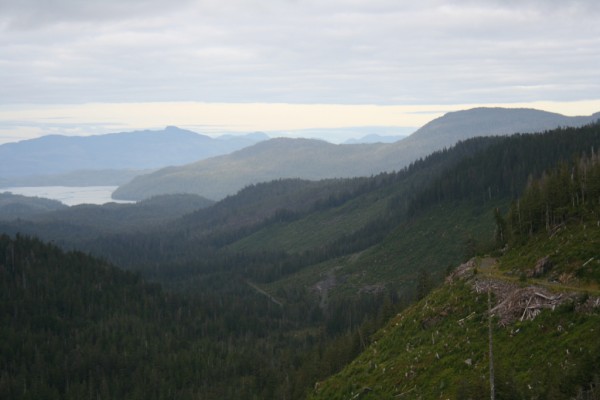
The U.S. Forest Service says a Friday court decision allowing a timber sale will help speed changes in Tongass National Forest logging. But opponents say it will damage other Southeast Alaska industries.
The Forest Service designed the Big Thorne sale as part of its transition from old-growth to second- or young-growth timber cuts.
Ten environmental organizations sued to block the sale, saying the acreage is critical habitat for deer and wolf populations, as well as salmon.
The ruling was made by U.S. District Court Judge Ralph Beistline. His 25-page decision rejects claims that the Forest Service failed to follow proper procedure before offering the sale.
Alaska Regional Forester Beth Pendleton was encouraged by the decision.
“It is critical to our overall transition and the ability to provide bridge timber to the industry here in Southeast, as we make that complete transition to young growth in the next 10 to 15 years,” she says.
The court decision allows the agency to proceed with the sale, which includes about 6,000 acres of old-growth rainforest on Prince of Wales Island. Another approximately 2,000 acres of second-growth trees are also included.
A suit, filed in August, said the agency did not properly consider the sale’s impacts on wildlife.
Southeast Alaska Conservation Council Executive Director Malena Marvin says logging Big Thorne would hurt other regional industries.
“We have a thriving fishing and tourism economy here and those are based on healthy streams and abundant wildlife and both of those things are undercut by old-growth logging,” she says.
Big Thorne is the largest timber sale planned for the Tongass, the nation’s biggest national forest.
The agency awarded a contract for about two-thirds of the acreage to Klawock’s Viking Lumber in October. It hoped to settle legal challenges in time for logging to start this spring.
But the lawsuit isn’t necessarily over. The plaintiffs could take the decision before the 9th Circuit Court of Appeals and seek an injunction pending the outcome.
SEACC’s Marvin says the environmental groups will discuss whether they’ll take that action. She says the suit includes views from more than those taking court action.
“In our experience, local people would much rather see a small and sustainable wood industry that actually keeps money circulating it in our communities instead of exporting old growth in the round to Asia,” she says.
Loggers say small communities want the opposite, a strong logging industry that provides good jobs.
The sale was first announced in the summer of 2013. Tongass officials said it could provide up to a decade’s worth of timber for Viking and smaller mills.
Environmentalists filed an agency appeal over impacts to wolves and other wildlife. They also pointed out that the area to be logged is home to about three-quarters of the world’s population of a rare orchid.
The Forest Service rejected that internal appeal, though it deferred offering some of the acreage.
Regional Forester Pendleton says Beistline’s ruling shows the agency did its homework.
“This decision really does validate the importance of the Big Thorne sale and the decision that was made associated with that,” she says.
The ruling came as the Tongass Advisory Committee prepares to meet in Juneau.
The 15-member panel is working on recommendations for an updated Tongass Land Management Plan, including the transition from old- to young-growth logging.
Ed Schoenfeld is Regional News Director for CoastAlaska, a consortium of public radio stations in Ketchikan, Juneau, Sitka, Petersburg and Wrangell.
He primarily covers Southeast Alaska regional topics, including the state ferry system, transboundary mining, the Tongass National Forest and Native corporations and issues.
He has also worked as a manager, editor and reporter for the Juneau Empire newspaper and Juneau public radio station KTOO. He’s also reported for commercial station KINY in Juneau and public stations KPFA in Berkley, WYSO in Yellow Springs, Ohio, and WUHY in Philadelphia. He’s lived in Alaska since 1979 and is a contributor to Alaska Public Radio Network newscasts, the Northwest (Public Radio) News Network and National Native News. He is a board member of the Alaska Press Club. Originally from Cleveland, Ohio, he lives in Douglas.




